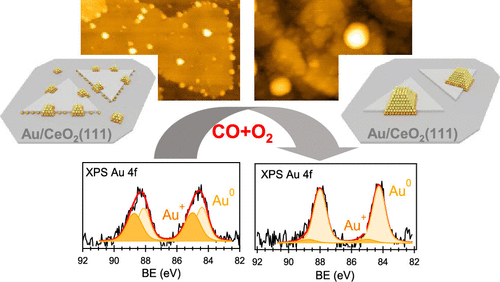
In this work, we prepared and investigated in ultra-high vacuum (UHV) two stoichiometric CeO2(111) surfaces containing low and high amounts of step edges decorated with 0.05 ML of gold using synchrotron-radiation photoelectron spectroscopy (SRPES) and scanning tunneling microscopy (STM). The UHV study helped to solve the still unresolved puzzle on how the one-monolayer-high ceria step edges affect the metal–substrate interaction between Au and the CeO2(111) surface. It was found that the concentration of ionic Au+ species on the ceria surface increases with increasing number of ceria step edges and is not correlated with the concentration of Ce3+ ions that are supposed to form on the surface after its interaction with gold nanoparticles. We associated this with an additional channel of Au+ formation on the surface of CeO2(111) related to the interaction of Au atoms with various peroxo oxygen species formed at the ceria step edges during the film growth. The study of CO oxidation on the highly stepped Au/CeO2(111) model sample was performed by combining near-ambient-pressure X-ray photoelectron spectroscopy (NAP-XPS), UHV-STM, and near-ambient-pressure STM (NAP-STM). This powerful combination provided comprehensive information on the processes occurring on the Au/CeO2(111) surface during the interaction with CO, O2, and CO + O2 (1:1) mixture at conditions close to the real working conditions of CO oxidation. It was found that the system demonstrates high stability in CO. However, the surface undergoes substantial chemical and morphological changes as the O2 is added to the reaction cell. Already at 300 K, gold nanoparticles begin to grow using a mechanism that involves the disintegration of small gold nanoparticles in favor of the large ones. With increasing temperature, the model catalyst quickly transforms into a system of primarily large Au particles that contains no ionic gold species.
More information can be found here: https://pubs.acs.org/doi/10.1021/acsami.2c15792.
© 2021 Matematicko-fyzikální fakulta Univerzity Karlovy.
Všechna práva vyhrazena. | Cookies